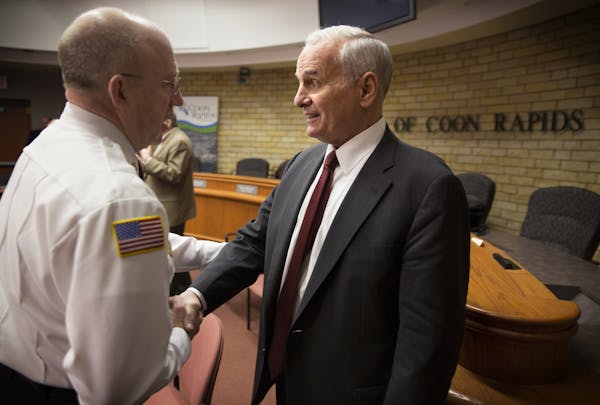Minnesota transportation officials said Wednesday that it will cost at least $280 million to upgrade railroad crossings on highways and roads where passing oil trains from North Dakota pose a risk of explosions and fires.
The study, mandated by the 2014 Legislature, comes one year almost to the day after a BNSF Railway train derailed in Casselton, N.D., triggering explosions and a fire that caused an evacuation but no injuries in the community 24 miles west of Fargo.
Some of the highest-risk areas identified by state analysts include twin road crossings southeast of Como Lake in St. Paul and an access road near the Treasure Island Resort & Casino in Red Wing, according to the report. Other risky sites were identified in Moorhead, Benson, Willmar, Wadena, Perham, Elk River, Coon Rapids and Minneapolis.
It is the first time that the Minnesota Transportation Department has analyzed the risk of potentially fiery explosions at grade crossings. In the past, railroad grade safety analyses focused on the risk of crashes, not on the danger to nearby residents.
"We did that because in the case of an oil fire on these lines with the volatile Bakken crude, our emergency guidance is that you have to evacuate the area for a half-mile," said Dave Christianson, who oversees freight railroad planning for MnDOT. "That is the burn radius of a major fire. That is the risk involved."
Christianson said the half-mile radius near where the BNSF tracks cross Como Avenue was the most densely populated of 100 sites studied. Three schools are within the evacuation zone, the report said. Although the crossings have safety gates, the report recommended separating rail and street traffic with a bridge at an estimated cost $25 million.
Rep. John Lesch, the DFL lawmaker whose district encompasses the Como intersection, and whose home is less than a half-mile from the site, said a large grade separation project likely will be a concern to the neighborhood.
"We're talking something like an interstate highway type of interchange, maybe not as big, but it would certainly impact the livability of the neighborhood," he said.
Beyond the vulnerability of the area's population, he said he has concerns about the environmental impact of such a project, including possible runoff into nearby Como Lake and the removal of green space to make way for a new intersection.
Legislators said railroads need to share more of the cost of such upgrades, which often are considered a state responsibility because railroad tracks predate roads and highways.
"This should not be a public expense alone," said Rep. Frank Hornstein, DFL-Minneapolis, who sponsored the oil train regulatory law that mandated the study. "The railroads are benefiting and profiting handsomely from oil trains crossing Minnesota. We get very little benefit."
A Canadian Pacific official had no immediate comment. BNSF spokeswoman Amy McBeth said the railroad hasn't fully reviewed the report, but is committed to grade crossing safety and has one of the lowest grade collision rates in the industry.
"If a community closes an at-grade crossing to build an overpass or underpass, BNSF does contribute toward those projects," she said in an e-mail. "We will continue working with MnDOT as we have for decades on these efforts."
Oil trains with 100 or more tank cars filled with Bakken crude oil cross the state at a rate of 37 to 52 trains per week on BNSF tracks and nine per week on Canadian Pacific's lines. Most of that traffic passes through Minneapolis and St. Paul and travels along the Mississippi River on its way east.
At least 15 major accidents involving crude oil or ethanol trains have occurred in the United States and Canada since 2006, including the July 2013 disaster at Lac-Mégantic, Quebec, that killed 47 people and incinerated part of the town.
Federal regulators are considering requiring stronger tank cars under new regulations to address the risk.
MnDOT said another high-risk site is in Red Wing, where Canadian Pacific tracks cross Sturgeon Lake Road. Christianson said that an oil train accident there would trigger evacuation of Treasure Island and the Prairie Island Indian community, and could shut off access to the nearby Prairie Island nuclear power plant. Upgrading that crossing to separate rail and road traffic would cost $14.2 million, the report said.
The price tags for the most expensive "priority" projects range from $10 million to $50 million each, for a total $243 million, the report said. Christianson said another $65 million to $70 million in smaller-scale upgrades were identified at other grade crossings across the state, he said.
Railroads typically pay about 5 percent of the cost unless grade crossing improvements are needed as part of a track expansion project, Christianson said. Several railroad-funded projects are in the works, but the state's total share likely will exceed $280 million, he added.
The Legislature in 2014 appropriated $2 million to address the problem. Since that isn't enough to fix any of the highest risk crossings, MnDOT recommended spending it on at least 10 smaller projects, including closing a road in St. Paul Park and improving warning signals at various places, including Elk River, Perham and Winona.
david.shaffer@startribune.com • 612-673-7090 • @ShafferStrib
janet.moore@startribune.com • 612-673-7752 • @MooreStrib

Trail section at one of Minnesota's most iconic spots closing for rehab

Will 'shotgun only' zone for deer in southern Minnesota be abolished?

Four Minnesotans catch salmonella in outbreak linked to basil sold at Trader Joe's

